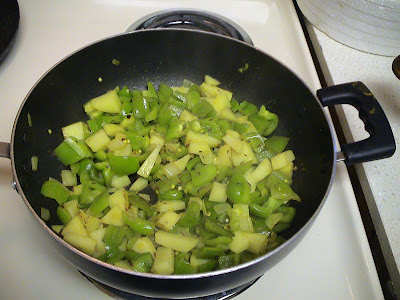Pasta Party!!!
Here are a couple of pasta recipies that I make on a regular basis. We love them and hope you will enjoy too.
Linguini in Roasted vegetable sauce
Ingredients:
Tomatoes - 2-3 cut into medium sized pieces or 1 cm thick slices.
Zucchini - 1 cut into 1 inch thick slices
Baby bell peppers or regular ones - a combination of red, green and yellow peppers cut into medium sized pieces - 1 cup
Method:
Sauce:
1. In a cup, put 3-4 tsps of olive oil, 1/2 tsp of Oregano, 1/2 tsp of Rosemary, 1/2 tsp of dried basil or a small bunch coarsely chopped, 1/2 tsp black pepper, 1/2 tsp of dried crushed red pepper (or as per spice level) and salt to taste. Mix it well.
2. Take a cooking brush and coat the baking pan lightly with the dressing you made in step 1.
3. Lay all the vegetables in the pan. Coat the vegetables with the dressing. You don't need to take each slice of vegetable and coat. Just spread the dressing around and pour the remaining into the pan itself.
4. Keep the pan in the oven and broil the vegetables. If you do not have broil setting, you can preheat the oven at 350 degrees and set it to bake. Broil the vegetables till they are slightly charred. in between randomly flip the vegetables around to let all sides char a bit. This gives a smoky flavor to the sauce.
5. when the vegetables are cooked aldente, remove it from the oven and let it cool. Coarsely, grind the vegetables in a food processor or any blender. Grind it such that you have small vegetable chunks. Do not add water or if it is too thick add very little water.
6. Sauce is ready
Pasta
1. Bring water to boil. Add about 1/2 tsp of salt, 2 tsps of Olive oil and add the pasta. Olive oil keeps the pasta from sticking to each other.
2. Cook pasta to aldente (there has to be a little crunch to the pasta).
3. Drain the water and put the pasta in a bowl. Pour the sauce over the pasta and mix well. Add more salt if needed.
Enjoy your pasta.
Pesto Pasta
Pesto pasta is a very healthy one since it is loaded with Antioxidants from olive oil and Omega -3 fatty acids from walnuts. It is traditionally made with pine nuts. Walnuts is also a good substitute. Walnuts is what I always use and it comes out great.
Ingredients
Basil - 1 medium sized bunch
Jalapeno (green chilli) - 1 (more or less depending on spice level)
Walnuts - 1 cup (or pine nuts)
Olive oil - half cup
Pasta - 3 cups
Method
1. Coarsely grind basil, Jalapeno and walnuts in a food processor or blender by adding olive oil little at a time. Pesto sauce is ready.
2. Heat water in a pasta pot (any vessel will do). When water starts to boil, add 2 tsps of salt and 2 tsps of olive oil and pasta . Cook till pasta is aldente.
3. In a pot, pour the pesto sauce. Add the pasta, add salt to taste and mix well.
Enjoy Pesto pasta.
Garlic, crushed redpepper pasta coming next...




















